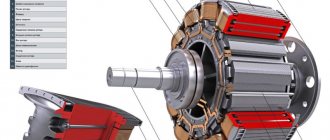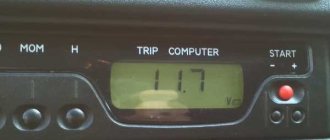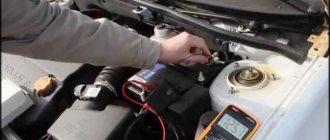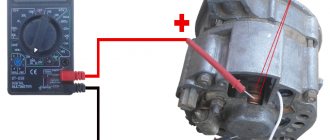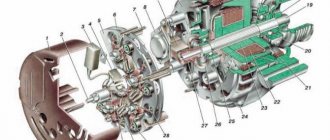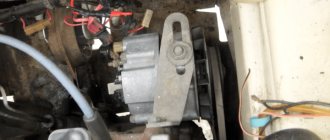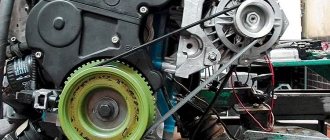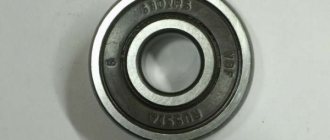Welcome, friends, to the DIY car repair website. The generator is, without exaggeration, the key component of a car. Its task is to power the entire electrical part of the vehicle while driving (cassette recorder, head light, navigator, and so on).
How to check a generator diode bridge
When the generator fails, the entire load is transferred to the battery. As a result, after just a few hours the car is completely immobilized.
Most car enthusiasts immediately go to a service station, where they spend a lot of money on repairs. Take your time - the problem in 90% of cases lies on the surface.
If you know how to test a generator diode bridge, you can quickly identify the problem, fix it and save money.
Removing and replacing a diode bridge on a VAZ 2101, 2102, 2103, 2104, 2105, 2106, 2107 (video)
Hello, from this article you will learn how to replace the diode bridge on VAZ 2101, 2102, 2103, 2104, 2105, 2106, 2107 cars. The diode bridge in the generator plays a key role, therefore, if it fails, the generator will not produce charge and soon the car’s battery will run out.
In principle, it is the burnt diode bridge that in most cases damages the generator. To replace the diode bridge, you will need to remove the generator from the car. To disassemble the generator and remove the diode bridge, you will need heads 8 and 10. First of all, you need to disassemble the generator into 2 parts; to do this, unscrew the nuts on the bolts that hold the generator housing together
Next, carefully tap one of the parts of the generator with a hammer to disassemble it.
The next step is to unscrew the head with an extension nut securing the diode bridge and, disconnecting the block from the generator, remove it
Installation of a new diode bridge occurs in the reverse order.
Source
Symptoms of a problem
The block is equipped with 6 diodes. Failure of even one of them “guarantees” the formation of voltage dips, which begin to deviate from the norm. At the same time, electromagnetic interference is generated. How to determine that the diode bridge of the generator is not working? Main symptoms:
- rapid discharge of the battery (the corresponding lamp on the dashboard flashes or stays on after the engine starts);
- the battery is recharged, leading to boiling off of the electrolyte;
- when driving, the headlights shine dimly;
- The power of the cabin “stove” and air conditioning is clearly not enough;
- The media system operates with distortion.
Failure of the diode bridge most often occurs due to water getting inside the generator (do not recklessly force deep puddles!). There is also a possible reason such as incorrect connection of the plus and minus when starting the engine using the “lighting” method.
Technical characteristics of the VAZ 2105 generator
Starting in 1986, 37.3701 generators began to be installed on “fives”. Before this, the car was equipped with the G-222 device. The latter had different stator and rotor coil data, as well as a different brush assembly, voltage regulator and rectifier. The generator set is a three-phase mechanism with excitation from magnets and a built-in rectifier in the form of a diode bridge. In 1985, the relay responsible for indicating the warning light was removed from the generator. The on-board network voltage was monitored only using a voltmeter. Since 1996, the 37.3701 generator has received a modified design of the brush holder and voltage regulator.
Table: parameters of generator 37.3701 (G-222)
| Maximum output current (at a voltage of 13 V and a rotor speed of 5 thousand min-1), A | 55(45) |
| Operating voltage, V | 13,6–14,6 |
| Engine-generator gear ratio | 2,04 |
| Direction of rotation (drive side) | right |
| Generator weight without pulley, kg | 4,2 |
| Power, W | 700 (750) |
Checking the diode bridge on the VAZ 2107 generator
In order for the car to be started, it contains a battery. In order to restore the battery capacity after starting the engine and ensure the normal operation of all electrical appliances, devices such as generators are used in the design of cars. Initially, they generate alternating current, and to convert it to direct current, a rectifier unit or diode bridge is used. We will look at how to check the diode bridge on a VAZ 2107 generator with your own hands below in the article.
The main function of the diode bridge on the VAZ 2107
The diode bridge of the VAZ 2107 generator is its integral and integral part, which serves to transform alternating current into direct current. The current is converted due to the fact that the vehicle's on-board network has a constant voltage of 12 V. An alternating current is supplied to the bridge, which is converted, and then goes to the battery in rectified form. And the voltage is removed from the battery and used to power all electrical appliances on the car.
This is interesting! Many people are accustomed to thinking that the on-board network of a car has a voltage of 12V. However, 12V is the battery voltage at rest, and in order to charge it, a charge of 13.5 to 14.5 volts must be generated. To ensure normal voltage supplied from the battery, the diode bridge is assembled from 2D219B diodes.
Signs and reasons why a diode bridge breaks
Malfunctions of the rectifier unit on the seven and other cars lead to complete immobilization of the car. If at least one diode located inside the generator fails, the supply of charging current to the battery will stop. The car will not drive for a long time without charging the battery (maximum 1.5-2 hours, provided that the car has a new and working battery and all electricity consumers are turned off) . Like all parts on a car, diodes tend to deteriorate (burn out), so if a decrease in the voltage of the on-board network is detected, which usually drops below 12V, and then begins to gradually fall, then the device should be checked and repaired.
The causes of breakdowns of the generator rectifier unit are as follows:
- Moisture getting into the generator. This can be either condensation or water that comes from outside during the operation of the car in rainy weather.
- Development of diode life. Usually in this case one diode fails, while all the others remain intact. The average service life of diodes is about 10 years, but it also depends on the mileage of the car.
- Burnout due to motorist negligence. Most often, diodes burn out when the car is not properly lit. If you light it incorrectly, then in this case you may have to change not only the diode bridge, but also the entire generator.
The first symptoms of rectifier unit breakdowns are identified by the following signs:
- The voltage of the on-board network decreases while the engine is running. This can be detected by the presence of an electronic voltmeter, which can be installed independently by the owner of the VAZ 2107. If the car has an on-board computer, it will also notify the driver of the malfunction. If there is no voltmeter or on-board computer, then a decrease in voltage can be diagnosed by such a sign as a decrease in the brightness of the lighting fixtures.
- The car loses power, and the longer you continue to drive with a faulty generator, the more the battery will discharge.
What generators can be installed on a VAZ 2105
The question of choosing a generator for a VAZ 2105 arises when the standard device is not capable of providing current to the consumers installed on the car. Today, many car owners equip their cars with powerful headlights, modern music and other devices that consume high current.
The use of an insufficiently powerful generator leads to undercharging of the battery, which subsequently negatively affects engine starting, especially in the cold season.
To equip your car with a more powerful source of electricity, you can install one of the following options:
- G-2107–3701010. The unit produces a current of 80 A and is quite capable of providing additional consumers with electricity;
- generator from VAZ 21214 with catalog number 9412.3701–03. The current produced by the device is 110 A. For installation, you will need to purchase additional fasteners (bracket, strip, bolts), as well as make minimal changes to the electrical part;
- product from VAZ 2110 for 80 A or higher current. For installation, a suitable mount is purchased.
Generator device
The main structural elements of a car generator are:
To know how the generator functions, you need to understand the purpose of each element in more detail.
On the VAZ 2105, the generator is installed in the engine compartment and is driven by a belt from the engine crankshaft.
Rotor
The rotor, also known as the armature, is designed to create a magnetic field. On the shaft of this part there is an excitation winding and copper contact rings, to which the coil leads are soldered. The bearing unit, installed in the generator housing and through which the armature rotates, is made of two ball bearings. An impeller and a pulley are also attached to the rotor axis, through which the mechanism is driven by a belt drive.
Stator
The stator windings create an alternating electric current and are combined through a metal core made in the form of plates. To avoid overheating and short circuits between the turns of the coils, the wires are coated with several layers of special varnish.
Frame
The generator housing consists of two parts and is made of duralumin, which is made to facilitate the design. To ensure better heat dissipation, holes are provided in the housing. By means of an impeller, warm air is expelled from the device to the outside.
Generator brushes
The operation of a generator set is impossible without elements such as brushes. With their help, voltage is supplied to the rotor slip rings. The embers are enclosed in a special plastic brush holder and installed in the corresponding hole in the generator.
Voltage regulator
The relay-regulator controls the voltage at the output of the unit in question, preventing it from rising above 14.2–14.6 V. The VAZ 2105 generator uses a voltage regulator combined with brushes and fixed with screws on the back of the power source housing.
Diode bridge
The purpose of the diode bridge is quite simple - to convert (rectify) alternating current into direct current. The part is made in the shape of a horseshoe, consists of six silicon diodes and is attached to the back of the case. If at least one of the diodes fails, the normal functioning of the power source becomes impossible.
Diode bridge functions
For charging and normal operation of the battery, direct current is required, but the generator produces only alternating current. To make the desired conversion, a diode bridge is used. The electronic components included in this unit conduct current in only one direction, rectifying it. The resulting voltage drops are smoothed out by the battery, “replacing” the capacitor. The functions of valves are most often performed by silicon diodes. However, it is possible to use other types of rectifiers - for example, selenium pillars.
Operating principle of the generator set
The “five” generator functions as follows:
- When the ignition is turned on, power from the battery is supplied to terminal “30” of the generator set, then to the rotor winding and through the voltage regulator to ground.
- The plus from the ignition switch, through the fuse-link “10” in the mounting block, is connected to contacts “86” and “87” of the charge warning lamp relay, after which it is supplied through the contacts of the switching device to the light bulb and then to the minus of the battery. The light is on.
- As the rotor rotates, a voltage appears at the output of the stator coils, which begins to power the excitation winding, consumers and charge the battery.
- When the upper limit of the voltage in the on-board network is reached, the relay regulator increases the resistance along the excitation circuit of the generator set and keeps it within 13–14.2 V. Then a certain voltage is supplied to the winding of the relay responsible for the charge lamp, as a result of which the contacts open and the light goes out. This indicates that all consumers are powered by the generator.
Generator faults
The Zhiguli generator is a fairly reliable unit, but its elements wear out over time, which leads to problems. Malfunctions can be of various types, as evidenced by characteristic signs. Therefore, it is worth dwelling on them, as well as on possible problems, in more detail.
The battery discharge light is on or flashing
If you observe that the battery charge light on a running engine is constantly on or flashing, then there may be several reasons for this behavior:
- insufficient tension of the generator belt drive;
- open circuit between the lamp and the generator;
- damage to the rotor winding power supply circuit;
- problems with the relay regulator;
- brush wear;
- damage to diodes;
- break or short circuit in the stator coils.
No battery charge
Even when the generator is working, the battery may not be charged. This may be due to the following reasons:
- the generator belt is loose;
- unreliable fixation of the wiring to the generator or oxidation of the terminal on the battery;
- battery problems;
- problems with the voltage regulator.
Diagnostic methods
There are two main methods that will allow you to determine the malfunction of the generator diode bridge. You need to choose based on what you have at hand. The first option requires the presence of a multimeter, and the most entry-level option, which is inexpensive, is suitable. The second is a regular 12V light bulb with three long wires so you can connect them to the right pins.
Diagnostics using a multimeter
Let's look at the option without removing the diode bridge, since it requires less time. The test is easy to carry out on an installed unit if you know the main features. The process is simple; you first need to provide access to the generator contacts. After this, carry out the following checks:
- When checking for a short circuit, press the positive contact of the multimeter to pin 30, and the negative contact to the body. If everything is in order with the diode bridge, the resistance readings will tend to infinity. Any other reading indicates a problem.
- To find out whether the positive diodes are broken, you should attach the positive terminal to pin 30 on the generator, and the negative terminal to the diode bridge mounting bolt. If everything is in order, the resistance will tend to infinity.
- To test the performance of negative diodes, you need to press the positive probe against the bolt that secures the diode bridge, and attach the negative probe to the housing. The readings should tend to infinity.
- To check additional diodes, the positive contact of the multimeter should be pressed to pin 61 on the generator, and the negative contact to the mounting bolt of the diode bridge. As in all cases above, the resistance should tend to infinity.
Do not forget to first switch the device to ohmmeter mode.
Using simple recommendations, you can literally check in a few minutes and find out whether the diode bridge has burned out or the reason lies in another unit. You can use not only a multimeter, but also any other device if it has an ohmmeter mode.
Checking the bridge with a light bulb
This option is especially good on the road, because it only requires a 12-volt light bulb and three long wires with bare ends. Or you can use a ready-made warning lamp, they are sold in car dealerships. In this case, proceed like this:
Generator check
If problems occur with the generator set, a unit check must be performed to determine the cause. This can be done in several ways, but the most accessible and common is using a digital multimeter.
Diagnostics with a multimeter
Before starting the test, it is recommended to warm up the engine at medium speed for 15 minutes, turning on the headlights. The procedure is performed as follows:
- We turn on the multimeter to measure voltage and take a measurement between terminal “30” of the generator and ground. If everything is in order with the regulator, then the device will show a voltage in the range of 13.8–14.5 V. If the readings are different, it is better to replace the regulator.
- We check the regulated voltage by connecting the probes of the device to the battery contacts. In this case, the engine should operate at medium speeds, and consumers should be turned on (headlights, heater, etc.). The voltage must correspond to the values installed on the VAZ 2105 generator.
- To check the armature winding, connect one of the multimeter probes to ground, and the second to the rotor slip ring. At low resistance values, this will indicate a faulty armature.
Video: diagnosing a generator with a light bulb and a multimeter
To be able to constantly monitor the battery charge voltage, I installed a digital voltmeter in the cigarette lighter, especially since I am not a smoker. This device allows you to always monitor the voltage of the on-board network without leaving the car and without lifting the hood to take measurements. A constant voltage indication immediately makes it clear that everything is in order with the generator or, conversely, if problems have arisen. Before installing the voltmeter, more than once I had to deal with problems with the voltage regulator, which were detected only when the battery was discharged or when it was being recharged, when the liquid inside simply boiled due to the excess of the output voltage.
At the stand
Diagnostics at the stand are carried out at the service, and if everything necessary is available, it is also possible at home.
- We mount the generator on the stand and assemble the electrical circuit. On the G-222 generator we connect pin 15 to pin 30.
Oscilloscope
Generator diagnostics are possible using an oscilloscope. However, not everyone has such a device. The device allows you to determine the health of the generator based on the signal shape. To check, we assemble the same circuit as in the previous diagnostic version, after which we perform the following steps:
- On the generator 37.3701, we disconnect the “B” terminal from the diodes from the voltage regulator and connect it to the battery positive through a 12 V car lamp with a power of 3 W.
- We turn on the electric motor on the stand and set the rotation speed to about 2 thousand min-1. We disconnect the battery using the toggle switch “6” and set the output current to 10 A using the rheostat.
- Using an oscilloscope, we check the signal at terminal “30”. If the winding and diodes are in good condition, the shape of the curve will be in the form of uniform saw teeth. In case of broken diodes or a break in the stator winding, the signal will be uneven.
How to check a diode bridge with a multimeter?
Proceed in the following sequence:
Remove the diode bridge from the generator (otherwise the test will not work). Each diode must be tested separately.
Set the multimeter to “beeper” mode. In this case, when the probes are closed, a characteristic squeak will be emitted. If there is no such function, you can set the tester switch to the “1 kOhm” position.
Touch the probes to the edges of one diode and take measurements by swapping the probes. The diode can be considered serviceable if it shows infinity in one direction and about 500-700 Ohms in the other.
If in both measurements the resistance is too low or, conversely, infinite, then the diode (group of diodes) is faulty.
Repair of VAZ 2105 generator
Having determined that the generator needs repair, it must first be removed from the car. To perform the operation you will need the following tools:
- keys for 17 and 19;
- heads for 10, 17 and 19;
- ratchet handle and knob;
- extension with cardan joint.
How to remove the generator
We dismantle the unit in the following order:
- Remove the negative terminal from the battery and disconnect the wiring from the generator.
Generator disassembly and repair
To disassemble the mechanism you will need the following list of tools:
- wrench and socket 10 with extension;
- hammer and adapter made of soft metal;
- bearing puller;
- crosshead screwdriver.
The operation consists of the following steps:
- Using a Phillips screwdriver, unscrew the fastening of the relay-regulator to the housing.
Video: generator repair on a “classic”
Generator belt
The flexible drive is designed to rotate the pulley of an electricity source, ensuring the functioning of the latter. Insufficient tension or a broken belt leads to a lack of battery charge. Therefore, despite the fact that the belt life is about 80 thousand km, its condition must be periodically monitored. If damage is detected, such as delamination, protruding threads or tears, it is better to replace it with a new product.
Many years ago, when I first purchased a car, I encountered an unpleasant situation - the alternator belt broke. Fortunately, this happened near my house and not in the middle of the road. I had to go to the store to buy a new part. After this incident, I always carry an alternator belt in stock, because it does not take up much space. In addition, when I carry out any repair work under the hood, I always check the condition of the flexible drive and its tension.
The VAZ Five uses an alternator belt 10 mm wide and 944 mm long. The element is made in the shape of a wedge, which allows it to more easily engage with the generator pulley, pump and crankshaft.
How to tension the alternator belt
To tension the belt you will need the following tools:
- mount;
- head for 17 and knob.
The procedure consists of the following steps:
- Check the tension level of the drive. Normal values are those at which the belt between the pump pulley and the crankshaft pulley bends by 12–17 mm or by 10–17 mm between the pump pulley and the generator pulley. When taking measurements, the pressure should not be more than 10 kgf in the location indicated in the image. To do this, press with the thumb of your right hand with moderate force.
Trouble-shooting
There are two main options for solving the problem. The first is accurate diagnostics on the bench: after detecting signs of burnt-out diodes, a check is carried out and it is determined which elements have failed. After this, the faulty diodes are soldered off, and new ones are soldered in their place. It is very important to take exactly the same brand; any analogues will not last long.
It is much easier to change the assembly, it is faster and of better quality, since you can be sure that the spare part will last for some time. The price of the part is low, for example, on a VAZ 2110 it is about 650 rubles. Replacement is not difficult and can be done independently.
Identifying a faulty diode bridge and replacing it is not difficult for any car enthusiast with a minimum set of tools. If the check shows a breakdown, it is best to remove the generator and carry out repairs. The process is simple and takes no more than an hour.
Source

